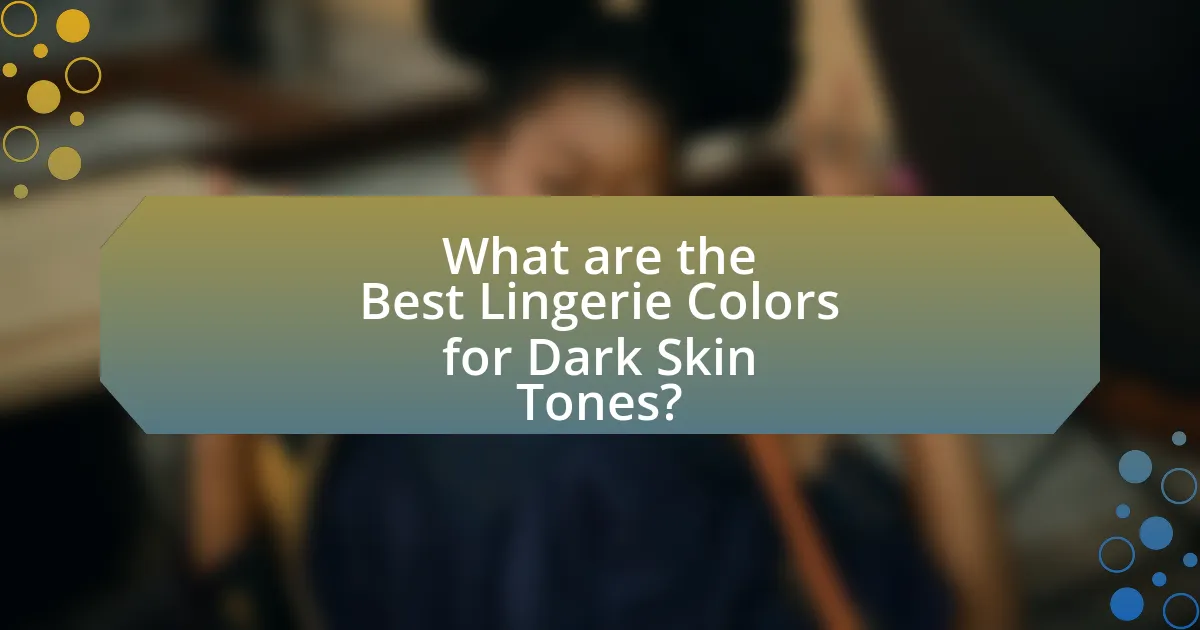The article focuses on identifying the best lingerie colors for different skin tones, categorized into fair, medium, olive, and deep. It discusses how skin tones influence color choices, emphasizing the importance of matching lingerie colors to enhance natural beauty and confidence. Recommendations include soft pastels for fair skin, rich jewel tones for medium skin, and vibrant shades for dark skin, supported by color theory principles. Additionally, the article addresses how undertones affect color selection and provides guidelines for avoiding unflattering shades, ensuring a visually appealing and harmonious look.

What are the Best Lingerie Colors for Different Skin Tones?
The best lingerie colors for different skin tones include nude shades that match the skin tone, deep jewel tones for medium skin, and vibrant colors like red or royal blue for darker skin tones. For fair skin, soft pastels such as blush or light lavender complement the complexion. Medium skin tones benefit from rich colors like emerald green or burgundy, which enhance warmth. Darker skin tones look stunning in bold colors like fuchsia or bright yellow, as these shades create a striking contrast. These recommendations are based on color theory and the way different hues interact with various skin undertones, ensuring a flattering appearance.
How do skin tones influence lingerie color choices?
Skin tones significantly influence lingerie color choices by determining which shades complement or contrast with an individual’s complexion. For example, lighter skin tones often look best in pastel colors, such as soft pinks and light blues, while deeper skin tones can be enhanced by vibrant hues like royal blue or rich burgundy. Research indicates that color theory suggests warm undertones in skin pair well with earthy tones, while cool undertones are complemented by jewel tones. This understanding helps consumers select lingerie that enhances their natural beauty and aligns with their personal style preferences.
What are the different categories of skin tones?
The different categories of skin tones are typically classified into four main groups: fair, medium, olive, and deep. Fair skin tones are characterized by light pigmentation and often have pink or peach undertones. Medium skin tones have a balanced mix of warm and cool undertones, allowing for a variety of shades. Olive skin tones possess a greenish or golden undertone, making them unique and versatile. Deep skin tones are rich in pigmentation, often with warm or cool undertones, and can range from dark brown to ebony. This classification is widely recognized in the beauty and fashion industries, aiding in the selection of suitable products, including lingerie colors.
How can undertones affect lingerie color selection?
Undertones significantly influence lingerie color selection by determining which shades complement an individual’s skin tone. Warm undertones, characterized by yellow or golden hues, typically pair well with colors like peach, coral, and warm reds, enhancing the natural glow of the skin. Conversely, cool undertones, which exhibit pink or blue shades, are best complemented by colors such as lavender, blue, and cool-toned pinks, creating a harmonious look. Neutral undertones can wear both warm and cool colors, allowing for a broader range of options. This understanding is supported by color theory, which emphasizes that colors can either enhance or detract from one’s natural complexion, making the selection of lingerie colors crucial for achieving a flattering appearance.
Why is it important to choose the right lingerie color?
Choosing the right lingerie color is important because it enhances the overall appearance and complements an individual’s skin tone. The right color can create a harmonious look, making the lingerie more visually appealing and boosting confidence. For instance, studies show that certain colors can evoke specific emotions and perceptions; for example, darker shades may convey sophistication, while lighter shades can suggest softness. Additionally, selecting colors that match or contrast well with skin tones can improve the fit and aesthetic of the lingerie, making it more flattering.
How does the right color enhance confidence and comfort?
The right color enhances confidence and comfort by aligning with an individual’s personal preferences and cultural associations, which can positively influence self-perception. For instance, studies show that colors like blue and green are often associated with calmness and stability, while red can evoke feelings of power and passion. When individuals wear colors that resonate with their identity or mood, they experience increased self-esteem and comfort in their appearance, leading to a more confident demeanor. Research published in the Journal of Experimental Psychology indicates that color can significantly affect emotional responses, further supporting the idea that the right color choice can enhance overall confidence and comfort.
What role does color play in the perception of lingerie?
Color significantly influences the perception of lingerie by affecting emotional responses and aesthetic appeal. Different colors evoke specific feelings; for instance, red is often associated with passion and desire, while black conveys sophistication and allure. Research indicates that color can impact consumer behavior, with studies showing that 85% of consumers make purchasing decisions based on color alone. Additionally, the choice of color can enhance or detract from the perceived fit and style of lingerie, making it essential for brands to consider color in their designs to align with consumer preferences and skin tones.

What are the Best Lingerie Colors for Fair Skin Tones?
The best lingerie colors for fair skin tones include soft pastels, light neutrals, and rich jewel tones. Soft pastels like blush pink, lavender, and baby blue complement the delicate undertones of fair skin, enhancing its natural glow. Light neutrals such as ivory and beige provide a subtle contrast that maintains an elegant look. Additionally, rich jewel tones like emerald green and royal blue create a striking visual appeal against fair skin, adding depth and vibrancy. These color choices are supported by color theory, which suggests that lighter shades harmonize with fair complexions while deeper hues provide a bold contrast that flatters the skin tone.
Which colors complement fair skin tones best?
Colors that complement fair skin tones best include soft pastels, jewel tones, and muted shades. Soft pastels like blush pink, lavender, and mint green enhance the delicate nature of fair skin, while jewel tones such as emerald green, sapphire blue, and rich burgundy provide a striking contrast that highlights the skin’s undertones. Additionally, muted shades like dusty rose and soft gray create a harmonious balance without overwhelming the complexion. These color choices are supported by color theory, which suggests that lighter skin tones benefit from shades that either contrast or harmonize without overpowering.
What are the recommended shades for fair skin?
The recommended shades for fair skin include soft pastels, light neutrals, and cool tones such as blush pink, lavender, and baby blue. These colors complement the lighter complexion by enhancing its natural brightness without overwhelming it. Additionally, shades like ivory and light beige can provide a subtle contrast, making them ideal for lingerie. Studies in color theory suggest that lighter shades harmonize with fair skin tones, creating a balanced and aesthetically pleasing appearance.
How do patterns and textures affect fair skin tones?
Patterns and textures can significantly enhance or detract from the appearance of fair skin tones. For instance, lighter patterns, such as soft pastels or delicate florals, tend to complement fair skin by providing a gentle contrast, while bold patterns can overwhelm the subtlety of lighter skin. Textures like lace or silk can add depth and dimension, creating a visually appealing contrast that highlights the skin’s natural luminosity. Research indicates that certain textures can reflect light differently, which can either accentuate or soften the overall look, making it essential to choose patterns and textures that harmonize with fair skin tones for the best aesthetic effect.
What should be avoided when choosing lingerie for fair skin?
When choosing lingerie for fair skin, it is advisable to avoid colors that are too pale or pastel, as they can wash out the complexion. Lingerie in shades like light beige, soft pink, or baby blue may blend into fair skin, making it less visually appealing. Dark colors, such as deep black or navy, can create a stark contrast that may be more flattering. This guidance is supported by color theory, which suggests that high contrast can enhance visual appeal, particularly for lighter skin tones.
Which colors can wash out fair skin tones?
Colors that can wash out fair skin tones include pastel shades, particularly light pink, baby blue, and pale yellow. These colors often lack contrast against fair skin, leading to a washed-out appearance. Additionally, neutral tones like beige and light gray can also diminish the vibrancy of fair skin. Studies in color theory indicate that high contrast colors, such as deep jewel tones, are more flattering for fair skin, while lighter shades can blend too closely with the skin tone, resulting in a lack of definition.
How can contrasting colors impact the overall look?
Contrasting colors significantly enhance the overall look by creating visual interest and emphasizing features. When used in lingerie, contrasting colors can highlight skin tones, making them appear more vibrant and appealing. For instance, a deep burgundy against fair skin can create a striking effect, drawing attention to the wearer. Studies in color theory indicate that high contrast can evoke emotional responses and increase visual engagement, which is particularly relevant in fashion and personal styling.

What are the Best Lingerie Colors for Medium Skin Tones?
The best lingerie colors for medium skin tones include rich jewel tones such as emerald green, royal blue, and deep burgundy, as well as warm shades like peach, coral, and soft pastels. These colors complement the undertones of medium skin, enhancing its natural glow. For instance, jewel tones provide a striking contrast that highlights the skin’s warmth, while warm shades blend harmoniously, creating a flattering look.
Which colors enhance medium skin tones?
Colors that enhance medium skin tones include jewel tones such as emerald green, royal blue, and rich purples. These colors complement the warm undertones typically found in medium skin, creating a vibrant contrast that highlights the complexion. Additionally, earth tones like terracotta and warm browns also work well, as they harmonize with the natural hues of medium skin. Studies in color theory suggest that these shades can enhance the overall appearance by providing a balanced and flattering look.
What are the most flattering shades for medium skin?
The most flattering shades for medium skin include rich jewel tones like emerald green, sapphire blue, and deep burgundy. These colors enhance the natural warmth of medium skin tones, providing a striking contrast that highlights the complexion. Additionally, earthy tones such as terracotta and warm taupe also complement medium skin, creating a harmonious look. Studies in color theory suggest that these shades resonate well with the undertones typically found in medium skin, making them ideal choices for lingerie.
How do different fabrics interact with medium skin tones?
Different fabrics interact with medium skin tones by enhancing or contrasting the natural undertones present in the skin. For instance, fabrics like silk and satin tend to reflect light, which can create a luminous effect on medium skin tones, making them appear more vibrant. Conversely, heavier fabrics such as cotton or denim may absorb light, potentially dulling the skin’s natural glow.
Additionally, the color of the fabric plays a crucial role; warm tones like peach or coral can complement medium skin tones, while cooler shades like navy or emerald can provide a striking contrast. Research indicates that the interplay of fabric texture and color can significantly influence the overall appearance and aesthetic appeal, particularly in lingerie, where the right combination can enhance the wearer’s confidence and style.
What should be avoided when selecting lingerie for medium skin?
When selecting lingerie for medium skin, it is advisable to avoid colors that are too dark or too light, as they can create an unflattering contrast. Dark colors like deep blacks or navy can overpower medium skin tones, while very light shades such as pastels may wash out the natural warmth of the skin. Research indicates that colors that closely match the undertones of medium skin, such as rich jewel tones or warm neutrals, enhance the overall appearance and complement the skin better.
Which colors may clash with medium skin tones?
Colors that may clash with medium skin tones include overly bright shades like neon yellow, harsh whites, and certain shades of orange. These colors can create an unflattering contrast against medium skin, often making the skin appear dull or washed out. For instance, neon yellow can overpower the natural warmth of medium skin tones, while harsh whites can create a stark contrast that may not be visually appealing.
How can one balance bold colors with medium skin tones?
To balance bold colors with medium skin tones, choose shades that complement the undertones of the skin, such as jewel tones like emerald green, royal blue, or deep purple. These colors enhance the natural warmth of medium skin tones without overwhelming them. Additionally, incorporating neutral accessories or layering pieces can help to soften the overall look, creating a harmonious balance. Studies in color theory indicate that contrasting bold colors with complementary tones can enhance visual appeal, making this approach effective for achieving a balanced aesthetic.

What are the Best Lingerie Colors for Dark Skin Tones?
The best lingerie colors for dark skin tones include rich jewel tones such as emerald green, royal blue, and deep burgundy, as well as vibrant shades like fuchsia and bright red. These colors complement the warmth and depth of dark skin, enhancing its natural beauty. Additionally, neutral shades like beige and chocolate brown can also work well, providing a subtle contrast that highlights the skin tone. Studies in fashion and color theory indicate that these colors create a striking visual appeal against darker complexions, making them popular choices in lingerie collections.
Which colors pop on dark skin tones?
Vibrant colors such as bright yellows, rich oranges, bold reds, and deep purples pop on dark skin tones. These colors create a striking contrast that enhances the natural beauty of darker complexions, making them visually appealing. For instance, studies in color theory indicate that warm tones tend to stand out against darker backgrounds, which is why these specific shades are often recommended for individuals with dark skin.
What are the most vibrant shades for dark skin?
The most vibrant shades for dark skin include rich jewel tones such as emerald green, royal blue, and deep purple. These colors enhance the natural warmth and richness of dark skin, creating a striking contrast that is visually appealing. Additionally, bold colors like fuchsia, bright red, and vibrant orange also complement dark skin beautifully, providing a lively and dynamic look. Studies in color theory suggest that these shades not only highlight the skin’s undertones but also create a sense of depth and vibrancy, making them ideal choices for lingerie.
How do metallics and jewel tones work with dark skin?
Metallics and jewel tones complement dark skin by enhancing its natural richness and depth. These colors, such as emerald green, royal blue, and deep purple, create a striking contrast that highlights the skin’s undertones. Additionally, metallic shades like gold and bronze add warmth and luminosity, making the skin appear radiant. Studies in color theory indicate that darker skin tones absorb light differently, allowing vibrant hues to stand out more vividly, thus creating an eye-catching effect.
What should be avoided when choosing lingerie for dark skin?
When choosing lingerie for dark skin, it is advisable to avoid colors that are too light or pastel, as they can create a stark contrast that may not be flattering. Light colors like pale pink, baby blue, or white can wash out the richness of darker skin tones, making them appear dull. Instead, deeper shades such as jewel tones or earth tones enhance the natural beauty of dark skin. This recommendation is supported by color theory, which suggests that contrasting colors can either complement or clash with skin tones, impacting overall appearance.
Which colors can appear dull on dark skin tones?
Muted or pastel colors, such as light pink, baby blue, and lavender, can appear dull on dark skin tones. This is because these lighter shades often lack the contrast needed to stand out against deeper skin tones, resulting in a washed-out effect. Research indicates that colors with low saturation do not provide the vibrancy that darker complexions can showcase, making them less flattering in comparison to bolder hues.
How can one ensure contrast without overwhelming dark skin?
To ensure contrast without overwhelming dark skin, one should choose lingerie colors that are rich and vibrant, such as jewel tones like emerald green, royal blue, and deep burgundy. These colors provide a striking contrast against dark skin without appearing too harsh. Additionally, incorporating lighter shades like soft pastels or whites as accents can enhance the overall look while maintaining balance. Research indicates that colors with high saturation levels complement darker skin tones effectively, creating a visually appealing contrast that is both flattering and elegant.
What are some tips for selecting lingerie colors based on skin tone?
To select lingerie colors based on skin tone, choose shades that complement your natural complexion. For fair skin, soft pastels like blush or light blue work well, while medium skin tones benefit from jewel tones such as emerald or sapphire. Dark skin tones are enhanced by vibrant colors like fuchsia or deep red. These recommendations are based on color theory, which suggests that contrasting colors can create a visually appealing look.
How can one determine their skin tone accurately?
To determine skin tone accurately, one should examine the undertones of their skin, which can be categorized as warm, cool, or neutral. This can be done by observing the veins on the wrist; if they appear blue, the skin tone is likely cool, while greenish veins indicate a warm tone. Additionally, holding a piece of white paper next to the face can help; if the skin looks yellowish, it is warm, and if it appears pink or rosy, it is cool. This method is supported by dermatological practices that emphasize the importance of undertones in identifying skin tone for cosmetic purposes.
What are some general guidelines for mixing and matching colors?
To effectively mix and match colors, start by using the color wheel as a guide, focusing on complementary, analogous, or triadic color schemes. Complementary colors, which are opposite each other on the wheel, create high contrast and vibrant looks, while analogous colors, which are next to each other, provide a harmonious and cohesive appearance. Triadic schemes, involving three colors evenly spaced on the wheel, offer a balanced yet dynamic palette. Research indicates that understanding color theory enhances aesthetic appeal and can influence perceptions of style and confidence.












